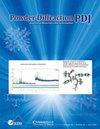Crystal structure of ribociclib hydrogen succinate, (C23H31N8O)(HC4H4O4)
IF 0.4
4区 材料科学
Q4 MATERIALS SCIENCE, CHARACTERIZATION & TESTING
引用次数: 0
Abstract
The crystal structure of ribociclib hydrogen succinate (commonly referred to as ribociclib succinate) has been solved and refined using synchrotron X-ray powder diffraction data, and optimized using density functional theory techniques. Ribociclib hydrogen succinate crystallizes in space group琥珀酸利福昔布氢(C23H31N8O)(HC4H4O4)的晶体结构
我们利用同步辐射 X 射线粉末衍射数据解决并完善了琥珀酸瑞博西利氢酯(通常称为琥珀酸瑞博西利)的晶体结构,并利用密度泛函理论技术对其进行了优化。琥珀酸瑞博昔单抗在空间群 P-1 (#2) 中结晶,a = 6.52215(4),b = 12.67120(16),c = 18.16978(33)埃,α = 74.0855(8),β = 82.在 295 K 时,晶体结构由平行于 ab 平面的阳离子和阴离子交替层组成。每个 ribociclib 阳离子中质子化的 N 在与两个不同的琥珀酸阴离子的两个强 N-H⋯O 氢键中充当供体。强 O-H⋯O 氢键将琥珀酸氢阴离子连接成平行于 a 轴的链。N-H⋯N 氢键将阳离子连接成二聚体,图集为 R2,2(8)。结果形成了一个三维氢键网络。该粉末图样已提交给 ICDD,以便纳入粉末衍射文件™ (PDF®)
本文章由计算机程序翻译,如有差异,请以英文原文为准。
求助全文
约1分钟内获得全文
求助全文
来源期刊

Powder Diffraction
工程技术-材料科学:表征与测试
CiteScore
0.90
自引率
0.00%
发文量
50
审稿时长
>12 weeks
期刊介绍:
Powder Diffraction is a quarterly journal publishing articles, both experimental and theoretical, on the use of powder diffraction and related techniques for the characterization of crystalline materials. It is published by Cambridge University Press (CUP) for the International Centre for Diffraction Data (ICDD).
 求助内容:
求助内容: 应助结果提醒方式:
应助结果提醒方式:


